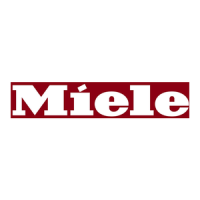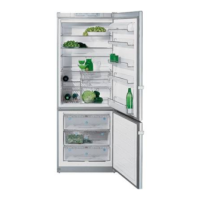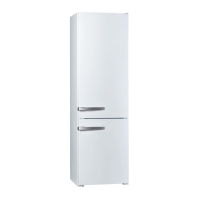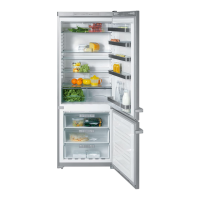Do you have a question about the Miele KFN 8462 SD and is the answer not in the manual?
Covers technical safety aspects, including coolant information, potential hazards, and precautions during installation and operation.
Defines the intended domestic use of the appliance and warns against improper or dangerous usage.
Initial preparation steps before first use, including cleaning and allowing the appliance to stand.
Instructions on how to turn on the refrigerator and freezer sections, including the master switch and On/Off button.
Details on how to turn off the entire appliance using the master switch and what to do if the safety lock is active.
Guidance on how to deactivate only the refrigerator section while keeping the freezer operational.
Specifies the ideal temperature for the refrigerator section, recommending 4 °C for optimal food storage.
Details the required temperature for freezing and storing frozen food, recommending colder than -18 °C.
Explains how to independently adjust the temperature settings for both the refrigerator and freezer sections using control buttons.
Troubleshooting steps for when the refrigerator or freezer section is not getting cool, checking power and settings.
Explains that a stuck freezer door is due to suction and advises waiting before trying again.
Troubleshooting tips for when the appliance is too cold, suggesting temperature adjustments and checking door closure.
Addresses frequent appliance switching by checking ventilation gaps, the rear grille, and door usage.
Provides advice on how to carefully separate frozen food that has frozen together using a blunt instrument.
Troubleshooting for alarm activation due to open doors or large amounts of food, and how to resolve it.
Explains that bars indicate temperatures outside the displayable range and advises checking after 6 hours.
Indicates that these codes signify a fault and require contacting the Service Department.
Explains 'nA' relates to power cuts and how to reset the alarm and view the warmest recorded temperature.
Identifies the safety lock as the reason the appliance cannot be switched off.
Troubleshooting for the interior light, checking door open duration or a defective lamp.
Addresses a wet floor by checking for a blocked drain hole and cleaning the condensate channel.
Recommends installing the appliance in a dry, well-ventilated room, avoiding direct sunlight and heat sources.
Specifies the appliance's operating climate ranges (ambient temperatures) and advises against exceeding them.
Emphasizes the importance of adequate ventilation at the back of the appliance for efficient operation.
Instructions on positioning the appliance, ensuring cable clips are removed and it's unhindered.
Guidance on adjusting the appliance's feet using a spanner to ensure it is level.
Covers technical safety aspects, including coolant information, potential hazards, and precautions during installation and operation.
Defines the intended domestic use of the appliance and warns against improper or dangerous usage.
Initial preparation steps before first use, including cleaning and allowing the appliance to stand.
Instructions on how to turn on the refrigerator and freezer sections, including the master switch and On/Off button.
Details on how to turn off the entire appliance using the master switch and what to do if the safety lock is active.
Guidance on how to deactivate only the refrigerator section while keeping the freezer operational.
Specifies the ideal temperature for the refrigerator section, recommending 4 °C for optimal food storage.
Details the required temperature for freezing and storing frozen food, recommending colder than -18 °C.
Explains how to independently adjust the temperature settings for both the refrigerator and freezer sections using control buttons.
Troubleshooting steps for when the refrigerator or freezer section is not getting cool, checking power and settings.
Explains that a stuck freezer door is due to suction and advises waiting before trying again.
Troubleshooting tips for when the appliance is too cold, suggesting temperature adjustments and checking door closure.
Addresses frequent appliance switching by checking ventilation gaps, the rear grille, and door usage.
Provides advice on how to carefully separate frozen food that has frozen together using a blunt instrument.
Troubleshooting for alarm activation due to open doors or large amounts of food, and how to resolve it.
Explains that bars indicate temperatures outside the displayable range and advises checking after 6 hours.
Indicates that these codes signify a fault and require contacting the Service Department.
Explains 'nA' relates to power cuts and how to reset the alarm and view the warmest recorded temperature.
Identifies the safety lock as the reason the appliance cannot be switched off.
Troubleshooting for the interior light, checking door open duration or a defective lamp.
Addresses a wet floor by checking for a blocked drain hole and cleaning the condensate channel.
Recommends installing the appliance in a dry, well-ventilated room, avoiding direct sunlight and heat sources.
Specifies the appliance's operating climate ranges (ambient temperatures) and advises against exceeding them.
Emphasizes the importance of adequate ventilation at the back of the appliance for efficient operation.
Instructions on positioning the appliance, ensuring cable clips are removed and it's unhindered.
Guidance on adjusting the appliance's feet using a spanner to ensure it is level.
| Appliance placement | Freestanding |
|---|---|
| Product colour | Stainless steel |
| Energy Efficiency Class | A++ |
| Height | 201 cm |
| Width | 60 cm |
| Cooling System | No Frost |
| Temperature Control | Electronic |
| Built-in display | Yes |
| Control type | Touch |
| Fridge interior light | Yes |
| Lamp type | LED |
| Number of shelves/baskets in fridge | 4 |
| Number of vegetable drawers | 2 |
| Door balconies | 4 |
| Egg balcony | Yes |
| Bottle rack | Yes |
| Number of shelves/baskets in freezer | 3 |
| Ice cube tray | Yes |
| Fresh zone compartment | Yes |
| Number of Shelves | 4 |
| Number of Door Bins | 4 |
| Defrosting System | Automatic |
| Reversible Door | Yes |
| Climate Class | SN-T |












